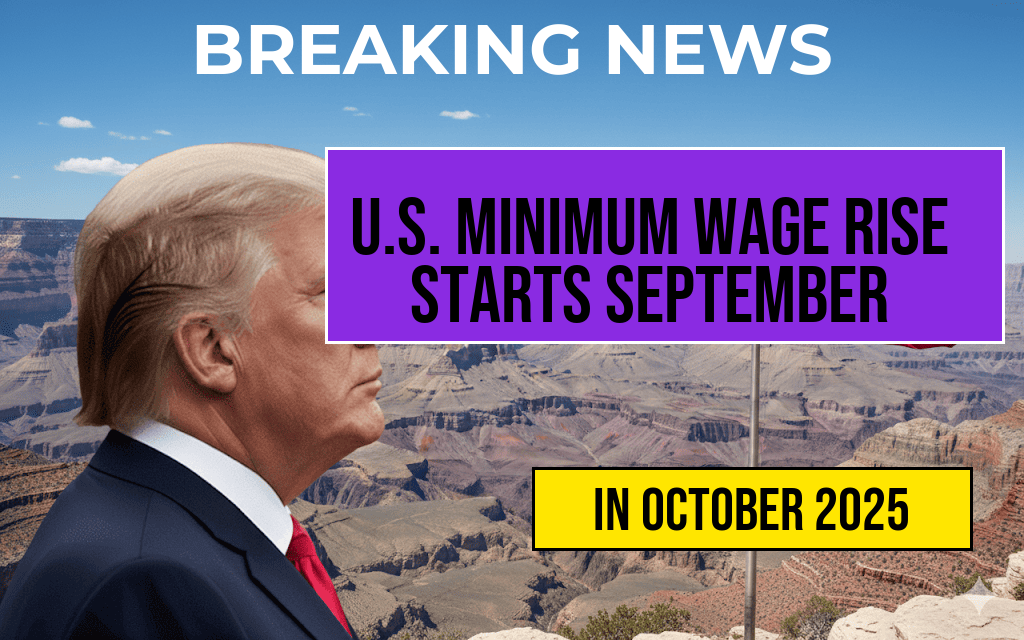The United States is set to implement a nationwide increase in the federal minimum wage starting September 30, 2025, marking a significant shift in labor standards across multiple states and industries. This adjustment follows recent legislative changes aimed at addressing wage stagnation and rising living costs. The new rates will vary depending on state and local regulations, with some regions adopting higher minimum wages than others. Employers nationwide will need to update payroll systems and inform workers of their revised earnings. This move is expected to impact millions of hourly workers, especially those earning close to the previous federal minimum of $7.25 per hour, which has remained unchanged since 2009. The increase aligns with broader economic efforts to balance wage growth with inflation, while also sparking discussions about potential impacts on employment and business operations.
Details of the 2025 Minimum Wage Increase
The federal government announced that effective September 30, 2025, the minimum wage will increase from the current rate of $7.25 per hour to $8.75 per hour. This adjustment is part of the Fair Minimum Wage Act of 2021, which stipulates periodic increases tied to inflation metrics. While federal rates serve as a baseline, numerous states and municipalities have their own minimum wage laws, which may set higher thresholds. Employers operating in regions with higher local minimum wages will need to adhere to those standards, resulting in a patchwork of new pay rates across the country.
How the Increase Varies by State
States with their own minimum wage laws often set rates above the federal baseline, and many are scheduled to increase further in 2025. For example:
- California: Minimum wage will rise to $15.50 per hour in 2025, with some cities like San Francisco and Los Angeles already setting higher local rates.
- New York: The state minimum wage will increase to $15.00 per hour, with New York City maintaining a higher local rate of $17.00.
- Florida: The minimum wage will grow to $11.00 per hour, with plans to reach $15.00 by 2026.
- Texas: Minimum wage remains aligned with the federal rate at $7.25, though some cities are considering local increases.
Many other states like Illinois, Massachusetts, and Washington have scheduled increases that surpass the federal baseline, reflecting regional economic conditions and cost of living adjustments. Employers should verify the specific rates applicable within their jurisdictions to ensure compliance.
Impacts on Employers and Workers
Business Considerations
Businesses, particularly those in retail, hospitality, and service industries, are preparing for increased labor costs. While some industry groups argue that higher wages could lead to increased prices or reduced employment opportunities, others point to benefits such as improved employee retention and productivity. Employers are advised to review their payroll systems and adjust budgets accordingly. Small businesses may face particular challenges, prompting discussions about potential phased implementations or subsidies.
Worker Benefits and Economic Effects
For workers earning near the previous federal minimum, the increase promises immediate financial relief and a boost in purchasing power. Economists suggest that incremental wage hikes can contribute to reduced income inequality and greater economic stability for low-wage earners. However, some analysts warn that rapid increases may impose burdens on small businesses, possibly leading to layoffs or automation in certain sectors. Overall, the policy aims to strike a balance between supporting workers and maintaining economic competitiveness.
Legal and Policy Context
The scheduled increase is part of a broader federal effort to modernize wage standards, with ongoing debates about raising the minimum wage to $15 per hour nationwide. While federal legislation sets a baseline, states and localities retain authority to establish higher rates or implement different policies. Some regions, like Seattle and Washington D.C., have already adopted higher wages through local ordinances. Advocates for higher minimum wages argue that such measures reduce poverty and stimulate economic activity, whereas opponents cite concerns over employment effects and increased operational costs.
Additional Resources
| Region | Effective Date | Minimum Wage |
|---|---|---|
| Federal | September 30, 2025 | $8.75 |
| California | January 1, 2025 | $15.50 |
| New York | December 31, 2024 | $15.00 |
| Florida | September 30, 2025 | $11.00 |
| Texas | Ongoing | $7.25 (federal baseline) |
Frequently Asked Questions
What is the effective date of the new U.S. minimum wage increase?
The new minimum wage rates will become effective starting September 30, 2025.
Which states or regions are impacted by the minimum wage increase?
The article provides a full list of states and regions implementing the minimum wage increase on September 30, 2025, highlighting where the new hourly rates will apply.
What are the new hourly wage rates for different regions?
The full list details the updated hourly wages for each state and region, reflecting the minimum wage adjustments effective from September 30, 2025.
How will the minimum wage increase affect employers and employees?
The wage increase aims to improve employee earnings and reduce income inequality. Employers may need to adjust payroll and budget accordingly.
Are there any exceptions or special cases in the new minimum wage rates?
Some states or regions may have exceptions such as small business exemptions or employee classifications. The article details these special cases.

Leave a Reply